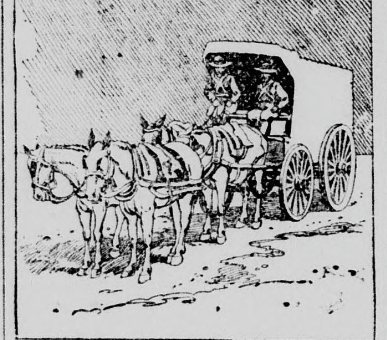
As we dive deep into the annals of history, we uncover a fascinating account originally penned in 1898 that outlines the complex orchestration required to ensure that the U.S. army was appropriately nourished.
“How the Army is Fed” provides a detailed, candid insight into the pivotal role of the quartermaster general and the logistic challenges of feeding a mobilized force in varied circumstances.
As we navigate through this historical account, we are privy to an intriguing inventory of soldier’s staples such as hard bread, bacon, and coffee, amongst others.
The emphasis on the importance of maintaining a healthy and fed army to ensure optimal fighting capacity speaks volumes of the strategic underpinnings involved in managing military sustenance.
Furthermore, we gain intriguing insights into the weight of the rations, cost per soldier, and even the intricacies of cooking in portable ovens. There’s an element of curiosity in learning about the ’emergency rations’ prepared for soldiers in extreme conditions, with even items like tobacco being considered essential for their well-being.
How the Army is Fed
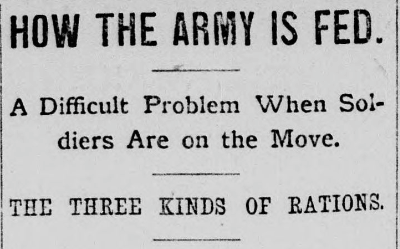
May 9, 1898 – What do you supposed your boy Charlie, who “has gone for a soldier,” is having for dinner today? Well, it depends on what stage of the fighting game Charlie has reached. You may feel assured, however, that wherever he is Uncle Sam is doing his level best to feed him well, both in quantity and quality, as is good for him. Not that Uncle Sam entertains any special regard for Charlie, but because he knows that the better a soldier is fed the better fighting he can do.
If Charlie is aboard a train somewhere as one of the units in a grand mobilization scheme, he is lucky to have any dinner at all. More than likely, he is munching crackers and drinking lukewarm coffee. Troops in course of transportation are hard t o reach, especially as they most frequently travel on special trains which are run on no stated schedule. Charlie may be laid off on some siding 20 or 30 miles from any agent of the quartermaster general or he may be on a troop transport with many miles of water between him and dinner.
Should Charlie be fortunate enough to have reached a regularly established army camp he is sure of a square meal that will taste as good as home cooking.
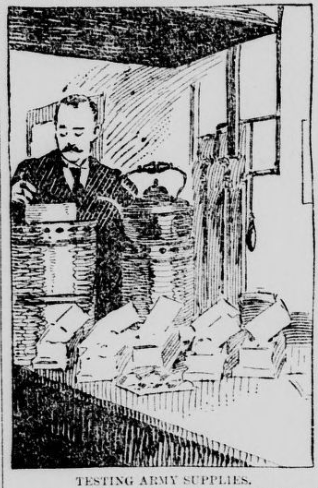
In case he is on the march, the meal will be less elaborate, but Charlie will not be particular. He will have an appetite that will transform the simplest fare into dainty viands.
This problem of feeding an army is a big and intricate one. It has all been studied out, however, by men who have made a science of it, and we have only to look on and wonder at how it is done. When an army is to be moved in a certain direction, the commissary officers are let into the secret and immediately make their preparations for the necessary three meals a day.
The first thing to be done is to establish a base of supplies. This must be far enough in the rear to be safe from the enemy and yet near enough to the front to be daily available.
In the case of the present mobilization of troops on our southern Atlantic seaboard, Tampa was selected as the base of supplies. At that point immense quantities of staples such as soldiers need have been collected.
Hard bread, bacon, beans, potatoes, and coffee are the chief of these staples, and they make up the larger part of Charlie’s bill of fare.
Uncle Sam has figured that it costs just 18 cents a day to feed a soldier. Sometimes, though, it costs an equal amount to get his food to him. The total rations for 1,000 men for one day weigh 3,307 pounds. One thousand men every 24 hours consume 750 pounds of bacon, 1,000 pounds of hard bread, 150 pounds of beans, 1,000 pounds of potatoes, 80 pounds of roasted and ground coffee, 150 pounds of sugar, 20 gallons of molasses, 10 gallons of vinegar, 40 pounds of salt, 40 pounds of soap, 15 pounds of candles, and 2-1/2 pounds of black pepper.
These are field rations. They do not eat the candles, be it understood – at all events, not unless an extreme emergency should arise.
Most of the cooking during the campaign is done in portable ovens, which are folded up when not in use, inclosing the culinary utensils. In camp the apparatus unfolds into a skeleton stove, on which may be prepared at one time 200 pounds of meat or fish, 55 pounds of bread and 90 pounds of vegetables and puddings.
When practicable, fresh meat, fresh vegetables, and fresh baked bread are substituted for the ration above described, each man receiving 1-1/4 pounds of beef or mutton, a pound of flour and a pound of vegetables.
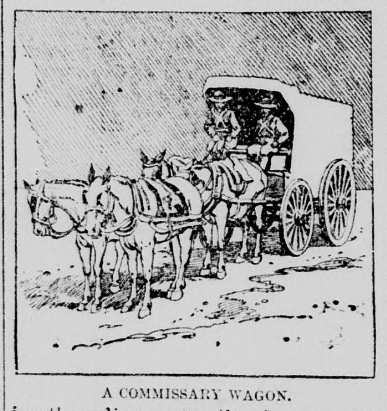
Separate and distinct from the field ration is the emergency ration which is issued when a body of troops is sent off at such a distance as to be beyond communication with the base of supplies.
About two years ago a board of army officers was ordered to convene in Washington to get up an “emergency ration” for the army. After many months of hard work the present ration was adopted.
The first point the board had to decide was what constituted the “emergency,” and it was decided that an emergency was such an occasion that required the troops to subsist on food carried on their persons.
After deciding this point the next point was what foods were the most nutritious and could at the same time be put up into the smallest form.
After many experiments the following ration was decided upon: Bacon, 10 ounces; hard bread, 16 ounces; pea meal, 4 ounces, or an equivalent in approved material for making soup; coffee, roasted and ground, 2 ounces, or tea, half ounce; saccharin, 4 grains; salt, .64 ounce; pepper, .04 ounce; tobacco, half ounce.
The total of the weight for five days is a little over ten pounds. This ration is never issued for over five days, the board having decided that such time was the minimum time for which men could live on the ration, still keep up their physical strength, and be in good fighting condition.
This ration is kept in the commissary storehouses at all military posts ready for immediate use. It is put up in small packages. The bacon, cut into a piece weighing 50 ounces, is wrapped up in a paper prepared for the purpose and kept in stock. The pea meal comes wrapped and resembles a thick, short roman candle. A man would carry five, one for each day’s ration. The hard bread is not the proverbial “hard tack” of olden times. It comes in the shape of small oyster crackers, one pound to a box.
Small cotton bags are issued in which to carry the roasted and ground coffee and the salt. A small brown paper box, like a pill box, contains the pepper, while the ten saccharin tablets (extra strong) are carried in another small pill box. Each tablet contains two grains, the box holding ten, two for each day. These tablets are so strong that a small piece will sweeten a large cup of coffee or tea.
Each man carries in his haversack a folding meat can, with a handle that admits of its use as a kind of saucepan. With this and the bacon and pea meal fairly good soup can be made, coffee or tea being made in the tin cup. It may seem strange to find tobacco included. The board of officers fully considered this matter, and while it is not, of course, a food, it is used so generally by soldiers that they would rather go short on food than to go without their tobacco. Moreover, those habituated to its use suffer acutely when deprived of it. Hence the tobacco was added. The man who does not use tobacco would find no trouble in “swapping off” his tobacco to some other man who did use it for an equal amount of something to eat. Experience during the civil war proved this point fully.
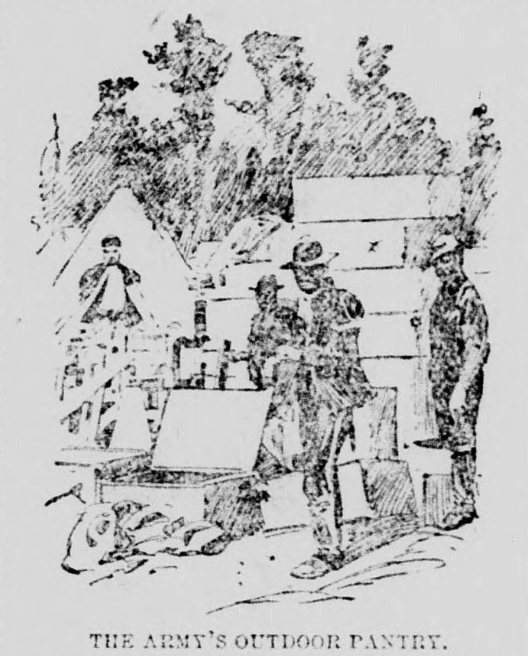
During the past summer several practice marches were made by regular troops throughout the country, on which marches the command lived for five days on this ration, and, while the men would not choose this form of food, experience proved that men can stand a great deal of hard work living on it. When Charlie has subsisted on this sort of food for two or three days, however, he will heartily wish for something different.
There is bound to be more or less experimenting done, too, by the men who have charge of the feeding of Uncle Sam’s fighters. Already dozens of patent food preparations have been submitted and some of them are to be given a trial. They will be tried on Charlie. Ten to one he will not like it, but he will have to submit.
A firm in Kansas City has perfected a system of sterilizing meat by a heating process, so that it can be kept a long time in the hottest climate. The process is a secret one, but its success has been demonstrated by the British army, which is using large quantities prepared by the Kansas City firm in its Sudan campaign.
It is understandable that a contract for a large quantity of this meat will be let immediately. It is put up in large tin cases after sterilization and hermetically sealed.
Another entirely new scheme which will be of great service to the army if compelled to remain long south is a method of putting up in one pound cans a good quality of coffee, all prepared with milk and sugar in proper quantities for drinking. All the soldier has to do is to heat as much as he wants and his coffee is ready. One can contains ten rations for a soldier and has the great advantage of being capable of preservation any length of time. The fact that it is easily transported and contains the sugar and milk, often difficult to obtain at all, makes this preparation of additional value. This also will undoubtedly be purchased in large quantities. It is to be hoped that Charlie will take kindly to it.
Source: Daily Kennebec journal. (Augusta, Me.), 09 May 1898.

